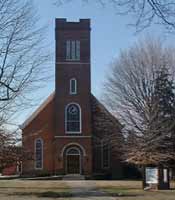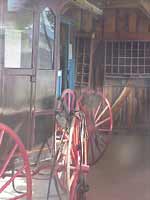Cummins Engine Company has a business presence in communities all over the
world, however, a unique architecture program has only been implemented in
 Bartholomew County and Primarily in Columbus, Indiana, where it has been a
source of pride for the Cummins Engine Company and the community. When the
Cummins Engine Foundation began the program in 1957 with the construction of
Lillian Schmitt Elementary School, the full architect fee for school design was
paid. This program later expanded to include other public buildings including
the Hope
Library 1998 and the Hope Elementary School 1989.
Bartholomew County and Primarily in Columbus, Indiana, where it has been a
source of pride for the Cummins Engine Company and the community. When the
Cummins Engine Foundation began the program in 1957 with the construction of
Lillian Schmitt Elementary School, the full architect fee for school design was
paid. This program later expanded to include other public buildings including
the Hope
Library 1998 and the Hope Elementary School 1989.
The primary requirement for participation in the CEF architectural program is
that the client must be a public agency in Bartholomew County and agree to
choose from a list of four to six architects offered by CEF. The Hope
Community, located in northeastern Bartholomew County has been fortunate to
receive architectural funds for the Library and Elementary School. Irwin Union
Bank also enhanced the community by adding a new branch bank building in
1958 and choosing from an international list of architects. This shows great
commitment to the community of Hope.
These three building add to the wealth of older architecture in the community
including the Moravian Church and the Methodist Church.
Hope Moravian Church
 Hope was built by members of the Moravian community. From 1830 to 1836 land
could only be owned by the Moravian Church and only rented by persons who were
members of the Moravian Church.
Hope was built by members of the Moravian community. From 1830 to 1836 land
could only be owned by the Moravian Church and only rented by persons who were
members of the Moravian Church.
The Methodist Church, Yellow Trails Museum, Band Stand, Rural Letter
Carriers Museum
The Methodist Church has a history all its own with its Beautiful
Stained glass windows and period architecture.
The Yellow Trails Museum will initiate you to the nearly 200 years of
history of the Hope Community.
The Band Stand in the large Park area, was designed by David Dixon in
1981. Dixon was from Ball State University School of Architecture. The simple
Band Stand is framed in steel with a 7 ½ Ton roof made of native lumber.
The Band Stand will encourage you to talk a stroll down memory lane as you walk
 past the Rural Letter Carriers Museum. This building, located in the
heart of the park, will remind you that Hope was the location of the first rural
letter carrier service in the State of Indiana. It is well worth a drive, along
Indiana State Highway 9, to this surprising little town of Hope, Indiana.
past the Rural Letter Carriers Museum. This building, located in the
heart of the park, will remind you that Hope was the location of the first rural
letter carrier service in the State of Indiana. It is well worth a drive, along
Indiana State Highway 9, to this surprising little town of Hope, Indiana.
Hope
Library
Deborah Berke & Associates
New York, New York
Deborah Berke, Principal Architect
Built in 1998
The Hope
Library, located on the town square is a 6,000 square foot, 20,000
volume, fully computerized branch of the Bartholomew County Public Library.
The building's low height and iron-spotted bricks establish a rapport with
neighboring structures, yet the library remains a decidedly new building that
confidently expresses its civic role.
Irwin Union
Bank & Trust Company (Hope Branch)
Harry Weese
Chicago, Illinois
Built in 1958
The rust-red brick branch bank building at Hope was designed to fit a village
square Environment and features a glass clerestory, over which "floats" the roof
of pyramidal wooden domes. The new bank was designed to resemble the old Hope
State Bank building which was purchased by Irwin Union. And if you step across
the street to the Gold Nugget Pawn Shop, inside you can still see the resemblance.
Hope Elementary School
Taft Architects
Houston, Texas
Built in 1989
The new elementary school on the out-skirts of Hope replaced the original
town school, which at one time housed grades 1-12 in this northeastern
Bartholomew County community. The center hallways is the "main street" of the
building with large foyers at each end. It creates a mall-like appearance with
classroom windows interspersed with masonry pillars.
The facility is located close to a park which utilized the remainder of the
29-acre site which was the first landscaping project funded by the foundation.
An old one-room school building has been moved to the site as a reminder of the
Hope community's rural past.
For more information on Architecture please visit the Columbus Area Visitor Center.